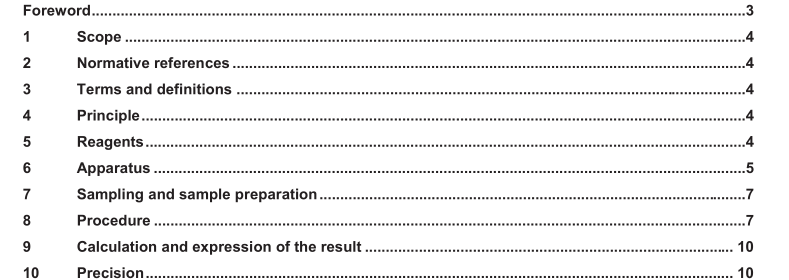EN 15476:2009 – Fertilizers – Determination of nitric and ammoniacal nitrogen according to Devarda

1 Scope
This European Standard specifies a method for the determination of nitrate and ammoniacal nitrogen with reduction using Devarda alloy (modified for each of the variants a, b and c).
The method is applicable to all nitrogenous fertilizers, including compound fertilizers, in which nitrogen is found exclusively in nitrate form or in ammoniacal and nitrate form.
2 Normative references
The following referenced documents are indispensable for the application of this document. For dated references, only the edition cited applies. For undated references, the latest edition of the referenced document (including any amendments) applies.
EN 1482-2, Fertilizers and liming materials — Sampling and sample preparation — Part 2: Sample preparation
EN 12944-1:1999, Fertilizers and liming materials and soil improvers — Vocabulary — Part 1: General terms
EN 12944-2:1999, Fertilizers and liming materials and soil inprovers — Vocabulary — Part 2: Terms relating to fertilizers
EN ISO 3696:1995, Water for analytical laboratory use — Specification and test methods (ISO 3696:1987)
3 Terms and definitions
For the purposes of this document, the terms and definitions given in EN 12944-1:1999 and EN 12944-2:1999 apply.
4 Principle
Reduction of nitrates and nitrites to ammonia in a strongly alkaline solution by means of a metallic alloy composed of 45 % Al, 5 % Zn and 50 % Cu (Devarda alloy). Distillation of the ammonia and determination of the yield in a known volume of standard sulfuric acid; titration of the excess sulfuric acid by means of a standard solution of sodium or potassium hydroxide.
5 Reagents
5.1 General
Use only reagents of recognized analytical grade and distilled or demineralized water, free from carbon dioxide and all nitrogenous compounds (grade 3 according to EN ISO 3696:1995).
5.2 Diluted hydrochloric acid , mix one volume of ρ (HCl) = 1,18 g/ml with one volume of water.
5.3 Sulfuric acid (for variant a), c = 0,05 mol/l.
5.4 Sodium or potassium hydroxide solution (for variant a), carbonate free, c = 0,1 mol/l.
5.5 Sulfuric acid (for variant b, see NOTE 2 in 8.4), c = 0,1 mol/l.
5.6 Sodium or potassium hydroxide solution (for variant b, see NOTE 2 in 8.4),carbonate free, c = 0,2 mol/l.
5.7 Sulfuric acid (for variant c, see NOTE 2 in 8.4), c = 0,25 mol/l.
5.8 Sodium or potassium hydroxide solution (for variant c, see NOTE 2 in 8.4),carbonate free, c = 0,5 mol/l.
5.9 Devarda alloy for analysis
Powdered in such away that a mass fraction of 90 % to 100 % will pass through a sieve with apertures less than 0,25 mm square, a mass fraction of 50 % to 75 % will pass through a sieve with apertures of less than 0,075 mm square.
Pre-packed bottles containing a maximum of 100 g are recommended.
5.10 Sodium hydroxide solution , 30 % of approximately ρ (NaOH) = 1,33 g/ml, ammonia free.
5.11 Indicator solutions
5.11.1 Mixed indicator
Solution A: Dissolve 1 g of methyl red in 37 ml of sodium hydroxide solution c = 0,1 mol/l and make up to 1 l with water.
Solution B: Dissolve 1 g of methylene blue in water and make up to 1 l.
Mix one volume of A with two volumes of B.
This indicator is violet in acid solution, grey in neutral solution and green in alkaline solution. Use 0,5 ml (10 drops) of this indicator solution.
EN 15476:2009 – Fertilizers – Determination of nitric and ammoniacal nitrogen according to Devarda